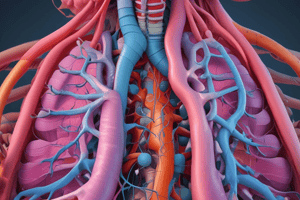Podcast
Questions and Answers
What is hysteresis in the context of the pressure-volume curve?
What is hysteresis in the context of the pressure-volume curve?
- It represents the point where the pressure is highest on the curve.
- It indicates the point where the lungs collapse during ventilation.
- It refers to the volume of air left in the lungs after maximum expiration.
- It is the area between the inflation and deflation limbs on the curve. (correct)
How does hysteresis impact the pressure-volume curve?
How does hysteresis impact the pressure-volume curve?
- It leads to the inflation and deflation limbs of the curve having different shapes. (correct)
- It results in the volume at any given pressure being consistent throughout ventilation.
- It makes it easier to inflate the lungs compared to deflating them.
- It causes both limbs of the curve to have the same shape.
How does increasing resistance to airflow affect hysteresis on the pressure-volume curve?
How does increasing resistance to airflow affect hysteresis on the pressure-volume curve?
- It has no effect on the shape of the curve.
- It makes the curve flatter with less variation in lung volume.
- It narrows the area between the inflation and deflation limbs.
- It widens the curve, making it appear broader. (correct)
What is the relationship between hysteresis and alveolar air-liquid surface forces?
What is the relationship between hysteresis and alveolar air-liquid surface forces?
How can changes in resistance to airflow be identified using pressure-volume curves?
How can changes in resistance to airflow be identified using pressure-volume curves?
What does the flow-volume loop describe?
What does the flow-volume loop describe?
Which of the following best describes premature cycling?
Which of the following best describes premature cycling?
What waveform pattern is indicative of premature cycling?
What waveform pattern is indicative of premature cycling?
Which of the following statements about delayed cycling is correct?
Which of the following statements about delayed cycling is correct?
What is a potential consequence of premature cycling?
What is a potential consequence of premature cycling?
How can premature cycling be addressed according to the text?
How can premature cycling be addressed according to the text?
Which of the following is NOT mentioned in the text as a potential solution for addressing asynchronies related to cycling?
Which of the following is NOT mentioned in the text as a potential solution for addressing asynchronies related to cycling?
What is the primary purpose of the volume versus time scalar?
What is the primary purpose of the volume versus time scalar?
How can differences between inspiratory and expiratory volumes be interpreted?
How can differences between inspiratory and expiratory volumes be interpreted?
What does the downslope of the volume versus time scalar represent?
What does the downslope of the volume versus time scalar represent?
How can the volume versus time scalar be used to evaluate ventilator settings?
How can the volume versus time scalar be used to evaluate ventilator settings?
What does the flow versus time scalar represent?
What does the flow versus time scalar represent?
What information can be derived from the area under the curve of the flow versus time scalar?
What information can be derived from the area under the curve of the flow versus time scalar?
What is the purpose of the pressure scalar displayed on the ventilator?
What is the purpose of the pressure scalar displayed on the ventilator?
During pressure control ventilation, what is the shape of the pressure scalar?
During pressure control ventilation, what is the shape of the pressure scalar?
What is the relationship between the plateau pressure (Pplat) and the peak inspiratory pressure (PIP)?
What is the relationship between the plateau pressure (Pplat) and the peak inspiratory pressure (PIP)?
Which of the following is NOT a factor that contributes to the peak inspiratory pressure (PIP)?
Which of the following is NOT a factor that contributes to the peak inspiratory pressure (PIP)?
What is the significance of the expiratory limb of the pressure scalar not returning to baseline before the new breath starts?
What is the significance of the expiratory limb of the pressure scalar not returning to baseline before the new breath starts?
What information can be obtained from the typical graphic display of the pressure versus time scalar on the ventilator?
What information can be obtained from the typical graphic display of the pressure versus time scalar on the ventilator?
What shape does the flow-volume loop take on in volume-controlled or flow-targeted modes?
What shape does the flow-volume loop take on in volume-controlled or flow-targeted modes?
In pressure-controlled modes, how is the flow represented on the flow-volume loop during inspiration?
In pressure-controlled modes, how is the flow represented on the flow-volume loop during inspiration?
What information can be obtained from evaluating the expiratory limb of the flow-volume loop?
What information can be obtained from evaluating the expiratory limb of the flow-volume loop?
What characteristic of the expiratory limb indicates potential airway obstruction or bronchoconstriction?
What characteristic of the expiratory limb indicates potential airway obstruction or bronchoconstriction?
How is air trapping identified on the flow-volume loop?
How is air trapping identified on the flow-volume loop?
What feature of the flow-volume loop may indicate the presence of an air leak?
What feature of the flow-volume loop may indicate the presence of an air leak?
Match the following authors with their respective publication on patient-ventilator asynchronies:
Match the following authors with their respective publication on patient-ventilator asynchronies:
Match the following journal titles with their respective publication year:
Match the following journal titles with their respective publication year:
Match the following publishers with their respective publications on patient-ventilator asynchronies:
Match the following publishers with their respective publications on patient-ventilator asynchronies:
Match the following links with their respective DOI numbers:
Match the following links with their respective DOI numbers:
Match the following content descriptions with their corresponding texts:
Match the following content descriptions with their corresponding texts:
The ______ pressure is the pressure measured at the end of inspiration when flow has stopped.
The ______ pressure is the pressure measured at the end of inspiration when flow has stopped.
The area under the curve of the ______ versus time scalar provides information about the delivered tidal volume.
The area under the curve of the ______ versus time scalar provides information about the delivered tidal volume.
A ______ limb on the expiratory portion of the flow-volume loop may indicate airway obstruction or bronchoconstriction.
A ______ limb on the expiratory portion of the flow-volume loop may indicate airway obstruction or bronchoconstriction.
The ______ versus time scalar is used to evaluate the cycling of the ventilator.
The ______ versus time scalar is used to evaluate the cycling of the ventilator.
An increased difference between inspiratory and expiratory ______ may indicate an air leak.
An increased difference between inspiratory and expiratory ______ may indicate an air leak.
Flashcards
Pressure vs. Time Scalar
Pressure vs. Time Scalar
Shows airway pressure over time. Used to identify plateau pressure (Pplat), the pressure in the airway during static conditions
Plateau Pressure (Pplat)
Plateau Pressure (Pplat)
Airway pressure during static lung inflation. Calculated by adding resistance, compliance, and PEEP pressures
Volume vs. Time Scalar
Volume vs. Time Scalar
Shows volume of gas delivered to lungs over time. Calculated from flow measurements
Flow vs. Time Scalar
Flow vs. Time Scalar
Signup and view all the flashcards
Patient-Ventilator Asynchrony (PVA)
Patient-Ventilator Asynchrony (PVA)
Signup and view all the flashcards
Pressure-Volume Loop
Pressure-Volume Loop
Signup and view all the flashcards
Flow-Volume Loop
Flow-Volume Loop
Signup and view all the flashcards
Pressure-Volume Curve
Pressure-Volume Curve
Signup and view all the flashcards
Flow-Volume Curve
Flow-Volume Curve
Signup and view all the flashcards
Study Notes
Ventilator Waveforms and Scalars
- There are three scalars: pressure versus time, volume versus time, and flow versus time.
- These scalars provide information about airway compliance, lung recruitment, and patient-ventilator asynchrony.
Pressure Versus Time Scalar
- The pressure scalar represents the pressure in the airway as a function of time.
- It is useful for identifying the plateau pressure (Pplat), which is the pressure in the airway under static conditions.
- The Pplat is calculated by adding the pressure created by airway resistance, the pressure related to the lung's compliance, and the total PEEP.
- The pressure scalar can also show other pressure measurements, such as PIP and PEEP.
Volume Versus Time Scalar
- The volume scalar represents the amount of gas delivered into the lungs by the ventilator over time.
- It is calculated from the measurement of flow.
- The upslope of the curve represents the inspiratory volume, and the downslope represents the expiratory volume.
- Differences in inspiratory and expiratory volumes can indicate air leaks or intrinsic positive end-expiratory pressure (auto-PEEP).
Flow Versus Time Scalar
- The flow scalar represents the gas flow in and out of the lungs.
- Inspiratory flow is a positive value on the graph, and expiratory flow is a negative value.
- The area under the curve represents the volume moved during inspiration and expiration.
- The shape of the flow curve can indicate changes in resistance to air flow or compliance of the lung.
Patient-Ventilator Asynchrony
- Patient-ventilator asynchrony (PVA) occurs when the patient is not interacting well with the ventilator.
- PVA can be associated with negative side effects, including increased sedation needs, increased work of breathing, and worse outcomes.
- PVA can be detected using ventilator graphic interpretation.
- There are several types of asynchrony, including:
- Asynchronies related to cycling: premature cycling, delayed cycling, and auto-triggering.
- Asynchronies related to breath initiation: auto-triggering.
- Asynchronies related to flow: flow starvation.
Loops
- Loops are graphical representations of the relationship between pressure or flow and volume during a breath.
- There are two types of loops: pressure-volume loops and flow-volume loops.
- The pressure-volume loop shows the pressure plotted against the volume during a breath.
- The flow-volume loop shows the flow plotted against the volume during a breath.
- Loops can provide information about respiratory mechanics, such as airway resistance and lung compliance.
Pressure-Volume Curve
- The pressure-volume curve is a graphical representation of the relationship between pressure and volume during a breath.
- The curve has an inspiratory and expiratory limb.
- The inspiratory limb takes on a sigmoidal shape, with an initial flat part, a middle steep part, and a flattening of the curve again.
- The curve can be used to identify changes in lung compliance and recruitment.
Flow-Volume Curve
-
The flow-volume curve is a graphical representation of the relationship between flow and volume during a breath.
-
The curve has an inspiratory and expiratory limb.
-
The curve can be used to identify changes in airway resistance and obstruction.
-
The curve can also be used to identify air trapping or auto-PEEP.### Ventilator Graphics and Respiratory Mechanics
-
The article "Essentials of ventilator graphics" by Restrepo and Khusid provides a comprehensive review of ventilator graphics in pediatric patients.
-
Ventilator waveforms are essential in assessing respiratory system mechanical function, as discussed in "Assessing Respiratory system mechanical function" by Restrepo et al.
-
A review of ventilator graphics and its use in assessing respiratory mechanics is provided by Dexter and Clark in "Ventilator graphics: scalars, loops, & secondary measures".
-
Lower tidal volumes are recommended for acute lung injury and acute respiratory distress syndrome, as demonstrated by the study "Ventilation with lower tidal volumes as compared with traditional tidal volumes for acute lung injury and the acute respiratory distress syndrome" by Acute Respiratory Distress Syndrome Network.
Respiratory Mechanics in Mechanically Ventilated Patients
- Respiratory mechanics in mechanically ventilated patients are discussed in "Respiratory mechanics in mechanically ventilated patients" by Hess.
- Fifty years of research in ARDS have led to significant advancements in understanding respiratory mechanics in acute respiratory distress syndrome, as discussed by Henderson et al. in "Fifty years of research in ARDS: Respiratory mechanics in acute respiratory distress syndrome".
Studying That Suits You
Use AI to generate personalized quizzes and flashcards to suit your learning preferences.




